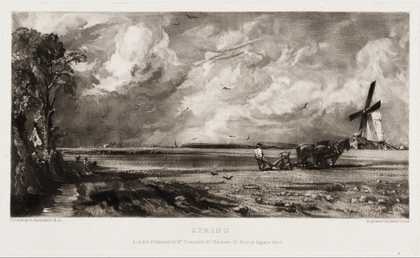
John Constable, David Lucas
Spring (published 1830)
Tate
John Constable died on 31 March 1837.
During his lifetime he sold few of his pictures and remained almost unknown to the British public.
His election as a member of the Royal Academy was delayed till he was 52 and when congratulated by the President, Sir Thomas Lawrence, he was told that he was fortunate to have been chosen when so many historical painters of merit were on the list of candidates. Fame, as such, was thus denied him while alive. His subjects were too humble and his manner of treating them too original for contemporary standards.
In France, on the other hand, standards had become unsettled. The Romantic Movement was beginning and school, law and tradition were less rigid and exacting than in England. Conditions were therefore more favourable to innovation and Constable found a ready acceptance among the artists of Paris. He was awarded a gold medal at the Louvre and his influence at once made itself felt in the art of the day.
Constable, like his father before him, began life as a miller. The mill in which he worked appears in one of his most enchanting sketches, Spring, and it was here that he acquired the knowledge which he was to use to such effect of the form and movement, the shape and illumination of clouds, the passage of light across the fields and the play of its vibrations on landscape.
In June 1800 Constable was admitted as a student at the Royal Academy and began his career as a painter: by 1801 he had already begun exhibiting.
Be that as it may, he had gained confidence, learnt much in the academy schools, and was quietly conscious of his powers. He was already convinced, to use his own words, that he would ‘make some good pictures which, though he might not reap the benefit, would be valuable to posterity’.
His final method, the method which was responsible for his finest work, was only attained comparatively late in his career. It can be seen here and there in his studies and sketches done in the first twenty years of the century, but it was only after 1820 that it appears in its full glory on his larger canvases. Like the poets, Constable was escaping from rule and formality and drawing closer to nature for inspiration.
Constable’s first awakening to landscape was in the country of the Stour. He attempted other scenery but the appeal of his native country grew stronger with the years.
In 1821 he wrote ‘Painting with me is but another word for feeling and I associate my careless boyhood with all that lies on the bank of the Stour. Those scenes made me a painter and I am grateful’.
